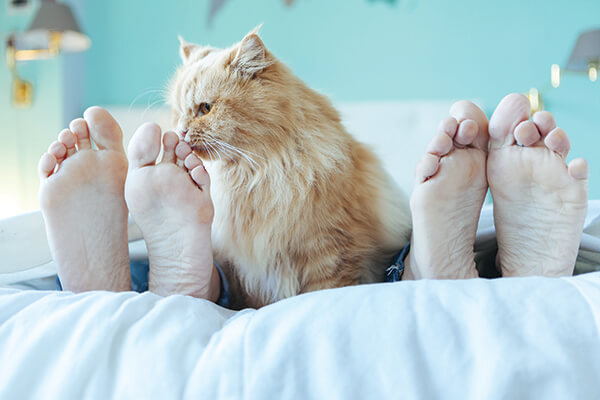Couples, kids, pets — is your bed too crowded? Consider these benefits and drawbacks of piling onto the same mattress

Editor’s note: Savvy mattress retailers want to do everything they can to help their customers sleep better, including offering them sound advice and tips. Feel free to share this great guidance from Better Sleep Council spokeswoman Lissa Coffey with your shoppers (with credit given, of course). The BSC is the consumer-education arm of the International Sleep Products Association.
It’s one thing to share a home — or even a room — with someone, but is there any benefit for family members to share a bed? We need our sleep! Lack of rest can lead to all sorts of heath challenges, including decreased immune function, chronic pain, irritability and depression. Does having another body nearby help us or hinder us? There are lots of good arguments on both sides. Let’s take a look, and you can see which side of the family bed debate you fall on.
Couples
In romantic relationships, both the quality and the quantity of sleep each partner receives has an impact on the harmony the couple experiences. Without restorative sleep, stress hormone levels rise while sex hormone levels fall. This can lead to tension, arguments and even sexual dysfunction. To keep your relationship healthy, each partner has to be healthy, which means getting the necessary sleep. Some couples find they prefer sleeping apart to rest more soundly.
The upsides of sleeping together
- For many busy couples, bedtime is the only time they have to talk and bond. And couples with children often find this is the only time they have alone together.
- Sexual health is closely linked to sleep health. The Journal of Circadian Rhythms published a study in 2005 that found married couples have the most sex between 11 p.m. and 1 a.m. This is more convenient when sharing the same bed.
- Affection and cuddling without sexual activity are important to foster feelings of connection and intimacy in a relationship. This often is part of a bedtime routine for happy couples.
The downsides of sleeping together
- For people with different sleep schedules, snoozing can be disturbed when one or the other gets in and out of bed.
- Many couples say snoring keeps them awake at night.
- Temperature preferences also can disrupt sleep for couples who share a bed. With that comes cover pulling and disagreements about thermostat adjustments.
- There also are individual preferences as to the light and sound levels in the room.
Of course, some adjustments can be made to help bring couples back to bed. For example, if a couple has different sleep schedules, they might opt for a mattress on which motion transfer is kept to a minimum. Changing sleep positions or using anti-snoring products might help with the snoring problem. Mattresses with dual controls are a good option for those who can’t agree on hot or cold, soft or firm.
Children
Co-sleeping with children is a controversial topic. And yet most parents report it happens — and often. While the American Academy of Pediatrics advises that babies should not sleep in the family bed for safety reasons, it does say sharing a room with baby is preferred for at least the first six months of the baby’s life. Although there is no significant health risk for older children to share the family bed, the arrangement has good and bad aspects.
The upsides of the family bed
- Historically and in many cultures around the world, children and parents have shared a bed.
- For mothers who breastfeed, sleep is less interrupted if the baby is nearby.
- Some parents say their children feel an increased sense of well-being and security from sleeping with their parents.
The downsides of the family bed
- Some children can become dependent on having a parent around for them to fall asleep. Children need to be able to learn to fall asleep on their own.
- Children need different amounts of sleep than adults, so parents may find themselves going to bed earlier than they want or keeping children up later than they should.
- Children are active sleepers, often kicking (ouch!) and sprawling out. This can disturb a parent’s sleep. To sleep, one parent or the other often moves to the child’s bedroom in the middle of the night.
- Having children in the bed greatly hinders a couple’s opportunity for intimacy.
At some point you’ll need to transition the kids out of the family bed and into their own beds. Having a sleep routine helps get them into good sleep habits. For my kids, it was bath, book, bed. A warm bath helped them to relax, reading a book with me helped them feel loved and confident, and then they were ready to be tucked in and go to sleep. It also helped that they had a race-car bed that fit a twin mattress. They loved it!
Pets
A recent study from the American Pet Products Association reports that almost 50% of dog owners allow their dogs to sleep in bed with them. In addition, 62% of cat owners share their bed with their cat. Pets often are considered to be members of the family, and we love to be around them as much as they love to be around us. Keeping them off the bed at night can be somewhat of a challenge. But is this helping our sleep or hurting it?
The upsides of sleeping with pets
- Pets give us comfort and help us relax, which, in turn, helps us to fall asleep.
- Having a pet nearby helps us to feel safer and less lonely.
- Pets help to keep us warm at night, giving us a cozy feeling.
- Pets help us get up in the morning: Fido wants a walk or Mittens wants her food, so we’re motivated to face the day rather than hit the snooze on the alarm.
The downsides of sleeping with pets
- Many people suffer from an animal allergy, and having pets in such close quarters could aggravate the condition.
- Pets dream, too. Dogs may wake us up when they are prancing joyfully in their dreams, and their legs run to match.
- Cats are nocturnal, and we aren’t. They may wake up and decide it’s time for their bath, feel the need to play or present us with a little surprise they found on the kitchen floor.
If you like the idea of having your pet in your room but not necessarily on your bed, try providing a special place for your buddy. Cats love to be high up and be hidden, so try installing a cat tree in the bedroom. A cat hammock in front of the window may be a great solution, too. You can put a dog bed next to your own bed, so Fido is nearby. Just position the dog bed so you don’t trip over Fido when you get up at night.

Lissa Coffey is a relationship expert, author of several books and broadcast journalist. A spokeswoman for the Better Sleep Council, she stars in several videos that offer sleep and mattress-shopping tips for consumers.

